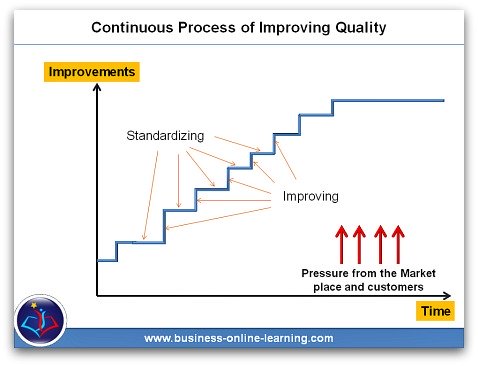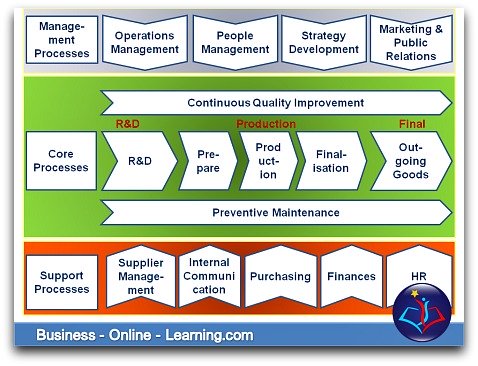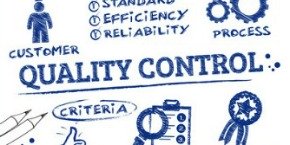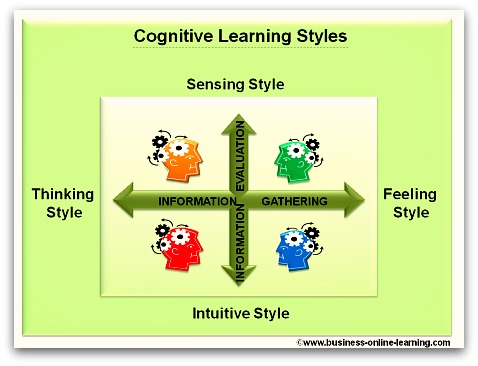What is Continuous Quality Improvement?
To start understanding what Continuous Quality Improvement is, we should take a look at the definition first:
Evolving from the concepts of Total Quality Management, Continuous Quality Improvement aims to look at the systemic rather that the systematic approach in Quality Management.
It determines that quality is to be defined from the customers point of view and by following this approach, you will achieve improvements in an organization's performance.
It encompasses an on-going series of small incremental improvements. See the following picture:
Every business is very much formed by the market it is in. What a customer is ready to pay for is what keeps a business profitable, so whatever the market says, the company should do.
This is the idea behind Continuous Quality Improvement. It is continually looking to see if the requirements of the customer are being met - consistently, and to improve the business accordingly.
Another important aspect is the idea of it being a continuous part of the work being done and not a once off event or project.
Rather than introducing huge and radical changes, the idea in Continuous Improvement is to change a little and often in small incremental steps, as these too will add up to improvements on a large scale and, by virtue of their quantity, they are changes that are more sustainable.
The Process for Continuous Improvement
Once the targets have been identified, the process for continuous improvement involves the main steps of
- Assessing the current state
- Determining what needs to be done to improve
- Implementing improvements
- Checking for desired outcome and standardizing the approach
This process is one of the core activities in the Six Sigma approach.
Six Sigma provides a rigorous, process based approach to continuous improvement which can be used to improve any business process.
The Six Sigma methodology identifies processes that are off-target and / or have a high degree of variation and corrects the process.
Is Continuous Quality Improvement
a Journey or A Destination?
It is a means to an end - and the end is the mission, vision or goal of the business.
Critical Steps
Regardless of the level upon which these continuous improvement activities take place, the following are critical steps that must take place in order for the continuous improvement to have any long term meaning at all. They are the key aspects you must manage if you wish your Continuous Improvement to be successful.
So, constantly keep your eye on the following:
- Training and Retraining Requirements
- Clear Process developments
- Delegation of clearly defined Projects (Consider giving Project charters)
- Management style and cultural change
- Effective personal and Organizational Communications (letting people know)
- Critical are the Financial measures, Operation measures and Customer measures along with Supplier, employee and environmental measures.
How is Progress Measured?
As mentioned above, one very clear management of the success of your activities is to use clear measures. Measure before you start, determine clear objectives and then measure again after the improvement activity has taken place.
Progress is therefor measured against clear objectives in
- Customer Quality
- Production realization
- Employee performance and satisfaction rates
- Production profitability / performance
- Service profitability / performance
- Innovation
- Environmental results
- Stakeholder values
You may well get some good ideas from this video I made on Problem Statements:
Improvement Activities Focus On Wastes Of:
Many of those involved in Improvement activities will focus on the topic of waste.
Waste is always undesirable, both from a business financial perspective as well as an environmental perspective.
These are the categories upon which you could start looking to improve your waste:
- Material
- Space
- Time
- Movement
- Effort
- Plant
- Cash
- Employee motivation
- Customer loyalty
Go to top of Continuous Quality Improvement page
or
For more information on any of the following areas, click on the picture:
|
Management Skills |
Communication |
Strategy | |
|
Concept Mapping |
Business Process Management |
 Problem Solving |
 Knowledge Management |
Business Online Learning Homepage ›
Dimensions of Quality ›
Continuous Quality Improvement



















 My name is Martha and I have worked for over 30 years in various aspects of business and in various countries, right around the world.
My name is Martha and I have worked for over 30 years in various aspects of business and in various countries, right around the world.